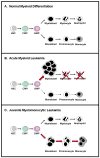Juvenile myelomonocytic leukemia: a report from the 2nd International JMML Symposium
- PMID: 18954903
- PMCID: PMC2692866
- DOI: 10.1016/j.leukres.2008.08.022
Juvenile myelomonocytic leukemia: a report from the 2nd International JMML Symposium
Abstract
Juvenile myelomonocytic leukemia (JMML) is an aggressive childhood myeloproliferative disorder characterized by the overproduction of myelomonocytic cells. JMML incidence approaches 1.2/million persons in the United States (Cancer Incidence and Survival Among Children and Adolescents: United States SEER Program 1975-1995). Although rare, JMML is innately informative as the molecular genetics of this disease implicates hyperactive Ras as an essential initiating event. Given that Ras is one of the most frequently mutated oncogenes in human cancer, findings from this disease are applicable to more genetically diverse and complex adult leukemias. The JMML Foundation (www.jmmlfoundation.org) was founded by parent advocates dedicated to finding a cure for this disease. They work to bring investigators together in a collaborative manner. This article summarizes key presentations from The Second International JMML Symposium, on 7-8 December 2007 in Atlanta, GA. A list of all participants is in Supplementary Table.
Figures


References
-
- Emanuel PD, Bates LJ, Castleberry RP, Gualtieri RJ, Zuckerman KS. Selective hypersensitivity to granulocyte-macrophage colony-stimulating factor by juvenile chronic myeloid leukemia hematopoietic progenitors. Blood. 1991;77:925–929. - PubMed
-
- Freedman MH, Cohen A, Grunberger T, Bunin N, Luddy RE, Saunders EF, Shahidi N, Lau A, Estrov Z. Central role of tumour necrosis factor, GM-CSF, and interleukin 1 in the pathogenesis of juvenile chronic myelogenous leukaemia. Br J Haematol. 1992;80:40–48. - PubMed
-
- Estrov Z, Zimmerman B, Grunberger T, Chao J, Teshima IE, Chan HS, Freedman MH. Characterization of malignant peripheral blood cells of juvenile chronic myelogenous leukemia. Cancer Res. 1986;46:6456–6461. - PubMed
-
- Altman AJ, Palmer CG, Baehner RL. Juvenile “chronic granulocytic” leukemia: a panmyelopathy with prominent monocytic involvement and circulating monocyte colony-forming cells. Blood. 1974;43:341–350. - PubMed
-
- Emanuel PD. Juvenile myelomonocytic leukemia. Curr Hematol Rep. 2004;3:203–209. - PubMed
Publication types
MeSH terms
Substances
Grants and funding
LinkOut - more resources
Full Text Sources
Miscellaneous

